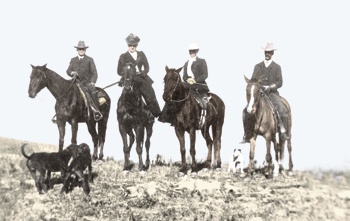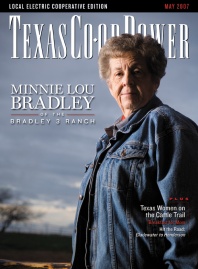Molly Goodnight’s branch of a distinguished Tennessee family migrated to a settlement near Fort Belknap in North Texas when she was 14. She married a hardscrabble cowboy with only six months of formal schooling, but he turned out to be one for the history books—Charles Goodnight, whose name adorned the Goodnight-Loving cattle trail. Goodnight’s cattle business, based in Pueblo, Colorado, collapsed in 1876, but he rebounded the next year when he joined John George Adair, an Irish financier, in a new venture. T Adair probably would not have been dabbling in cattle except for the fact that his wife, Cornelia Wadsworth Ritchie Adair, was as adventuresome as she was highborn.
Cornelia, a native of Upstate New York, had fallen in love with the West during a buffalo hunt. The unlikely foursome and their drovers moved the makings of the JA Ranch from Colorado to the Palo Duro Canyon. The drive included four wagons and enough supplies to last six months, 100 Durham bulls and sufficient horses to upgrade Goodnight’s Texas herd. T Cornelia rode a beautiful white horse the whole 400 miles, while Molly alternated between horse and wagon. Both were excellent horsewomen.
Charles Goodnight later insisted that the cattle had almost died of thirst when Molly mistook a patch of bear grass for a band of Indians in the distance and halted their movement south for a time. If she was concerned about Indians, she learned over the ensuing years to play the unflappable hostess to cattle-rustling Kiowas and Comanches. Charles gave them an allotment of beef to keep things peaceful.
According to historian Michaele Thurgood Haynes in Texas Women on the Cattle Trails, Molly’s [and Cornelia’s] “first sight of Palo Duro, named for the cedar trees, was breathtaking: a solitary canyon 1,500 feet deep, 10 miles wide and almost 100 miles long, with steep red cliffs on both sides. Since fencing was unnecessary, the canyon was ideal for raising cattle. … It was a beautiful sight, but getting the entourage down the old Indian trail took significant effort.”
The Goodnight/Adair party had to unload and disassemble the wagons and use ropes to lower the parts down into the valley. Next, the supplies bumped their way down. The cattle and horses trod gingerly down rocky trails. The process took eight days, and the group still had to move the supplies 10 more miles to a headquarters site. Once the Goodnights were established, the Adairs left them to do the actual ranch work.
At least during the 1870s, Haynes wrote, Molly was the only white woman within a 75-mile radius on the Texas High Plains. Besides the men, her companions were the bison and three chickens originally intended for Sunday dinner. She wrote to her sister, “No one will ever know how much company those chickens were.” She saw to it that enough buffalo were preserved to make up today’s Texas State Bison Herd.
Molly persevered as a ranch woman, teacher and healer. According to Women in Texas by Ann Fears Crawford and Crystal Sasse Ragsdale (Eakin Press, 1982), Molly’s home remedies included “coal-oil for lice, prickly pear for wounds, salt and buffalo tallow for piles, mud for inflammation and fever and buffalo meat broth for a general tonic.”
Cornelia traveled the world, but she became one of the largest female landowners in the country after her husband died. “She visited the JA each fall, riding the range with the cowboys and sharing their chuck wagon meals,” according to historian Frances B. Vick. The Canyon City newspaper called her “the English cattle queen.”
Kaye Northcott is the former editor of Texas Co-op Power.


